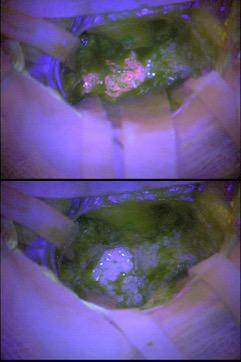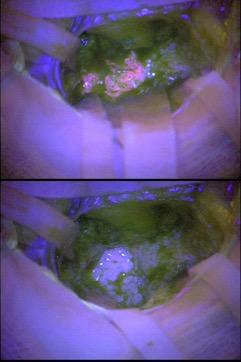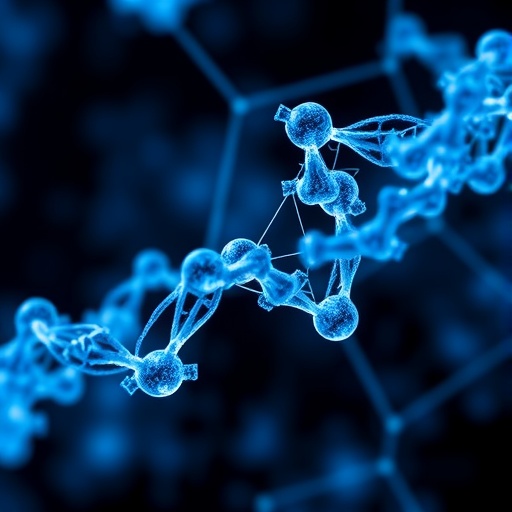
Credit: Colin Watts
Glasgow, UK: A chemical that highlights tumour cells has been used by surgeons to help spot and safely remove brain cancer in a trial presented at the 2018 NCRI Cancer Conference.
The research was carried out with patients who had suspected glioma, the disease that killed Dame Tessa Jowell, and the most common form of brain cancer. Treatment usually involves surgery to remove as much of the cancer as possible, but it can be challenging for surgeons to identify all of the cancer cells while avoiding healthy brain tissue.
Researchers say that using the fluorescent marker helps surgeons to distinguish the most aggressive cancer cells from other brain tissue and they hope this will ultimately improve patient survival.
The research was presented by Dr Kathreena Kurian, a Reader/Associate Professor in brain tumour research at the University of Bristol and consultant neuropathologist at North Bristol NHS Trust, UK. The study was led by Colin Watts, Professor of Neurosurgery and chair of the Birmingham brain cancer programme at the University of Birmingham, UK.
Dr Kurian explained: "Gliomas are difficult to treat with survival times often measured in months rather than years. Many patients are treated with surgery and the aim is to safely remove as much of the cancer as possible. Once a tumour is removed, it is passed on to a pathologist who examines the cells under a microscope to see if they are 'high-grade', fast growing cells, or 'low-grade' slower growing cells. And we can plan further treatment, such as radiotherapy or chemotherapy, based on that diagnosis.
"We wanted to see if using a fluorescent marker could help surgeons objectively identify high-grade tumour cells during surgery, allowing them to remove as much cancer as possible while leaving normal brain tissue intact."
The researchers used a compound called 5-aminolevulinic acid or 5-ALA, which glows pink when a light is shone on it. Previous research shows that, when consumed, 5-ALA accumulates in fast growing cancer cells and this means it can act as a fluorescent marker of high-grade cells.
The study involved patients with suspected high-grade gliomas treated at the Royal Liverpool Hospital, Kings College Hospital in London or Addenbrooke's Hospital in Cambridge, UK. They were aged between 23 and 77 years, with an average (median) age of 59 years. Before surgery to remove their brain tumours, each patient was given a drink containing 5-ALA.
Surgeons then used operating microscopes to help them look for fluorescent tissue while removing tumours from the patients' brains. The tissue they removed was sent to the pathology lab where scientists could confirm the accuracy of the surgeons' work.
A total of 99 patients received the 5-ALA marker and could be assessed for signs of fluorescence. During their operations, surgeons reported seeing fluorescence in 85 patients and 81 of these were subsequently confirmed by pathologists to have high-grade disease, one was found to have low-grade disease and three could not be assessed.
In the 14 patients where surgeons did not see any fluorescence, only seven tumours could be subsequently evaluated by pathology but in all these cases, low-grade disease was confirmed.
Professor Watts said: "Neurosurgeons need to be able to distinguish tumour tissue from other brain tissue, especially when the tumour contains fast-growing, high-grade cancer cells. This is the first prospective trial to show the benefits of using 5-ALA to improve the accuracy of diagnosing high-grade glioma during surgery. These results show that the marker is very good at indicating the presence and location of high-grade cancer cells.
"The advantage of this technique is that it may highlight more quickly high-grade disease within a tumour during neurosurgery. What this means is that more of the tumour can be removed more safely and with fewer complications, and that's better for the patient."
The researchers caution that the study looked at patients who were already suspected to have high-grade tumours, and a larger study in which more patients have low-grade disease would provide more information on the use of this technique. They say that other types of markers may need to be tested for detecting low-grade glioma cells.
Next steps could include testing the 5-ALA in children with brain tumours, or to help surgeons distinguish between tumour tissue and scar tissue in adult patients whose brain cancers have recurred following treatment.
Professor Anthony Chalmers is Chair of NCRI's Clinical and Translational Radiotherapy Research Working Group and Chair of Clinical Oncology at the University of Glasgow, UK, and was not involved in the research. He said: "There is a desperate need for better treatments for brain tumours and to achieve that we need more high quality research in this area.
"The benefit of using a fluorescent marker is that it helps neurosurgeons see more accurately where the high-grade cancer is within the brain, in real time. In treating cancer, we are trying to improve survival by tailoring treatments to each individual patient. This technique provides on-the-spot information to help surgeons tailor the operation according to the location, size and grade of the tumour. We know that patients who have near total removal of their tumour have better outcomes, so we are optimistic that, in the long term, these new data will help to increase survival times for glioma patients."
###
Media Contact
Kerry Noble
[email protected]
44-744-686-9433





